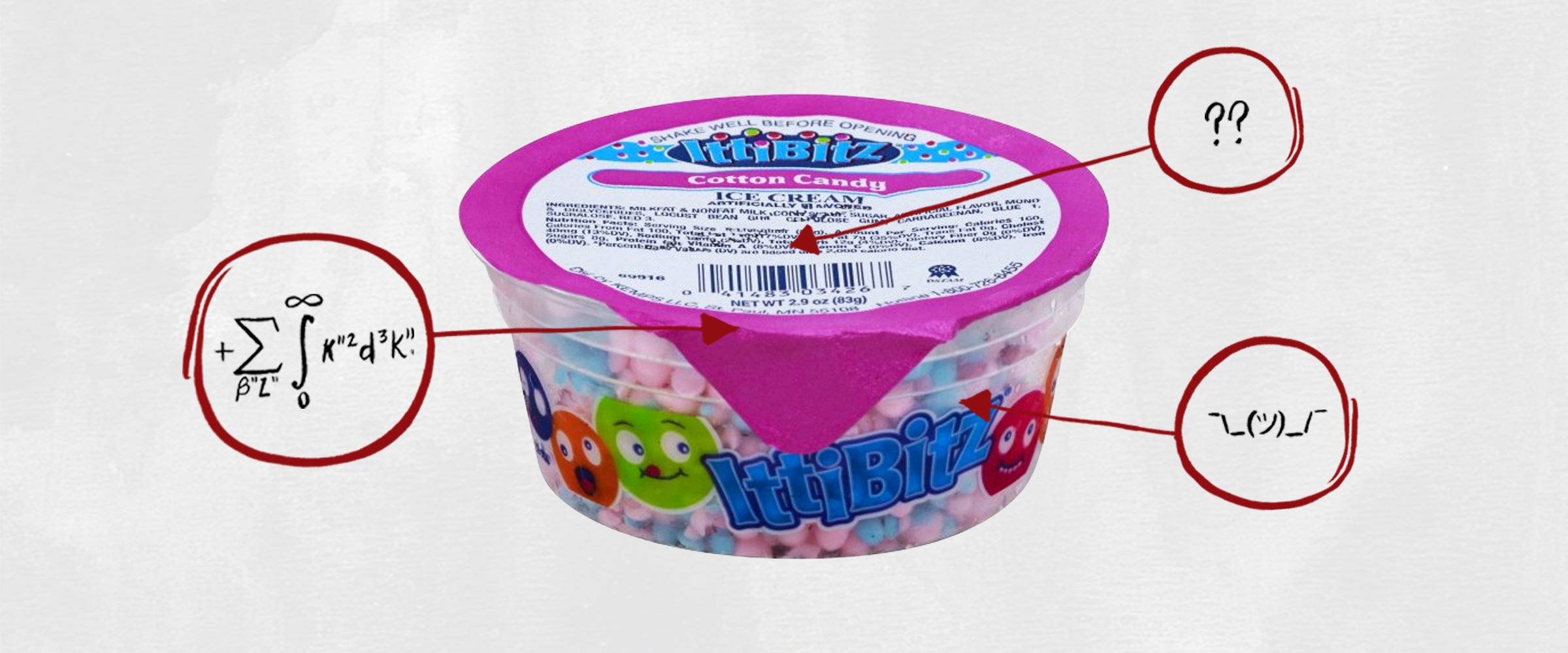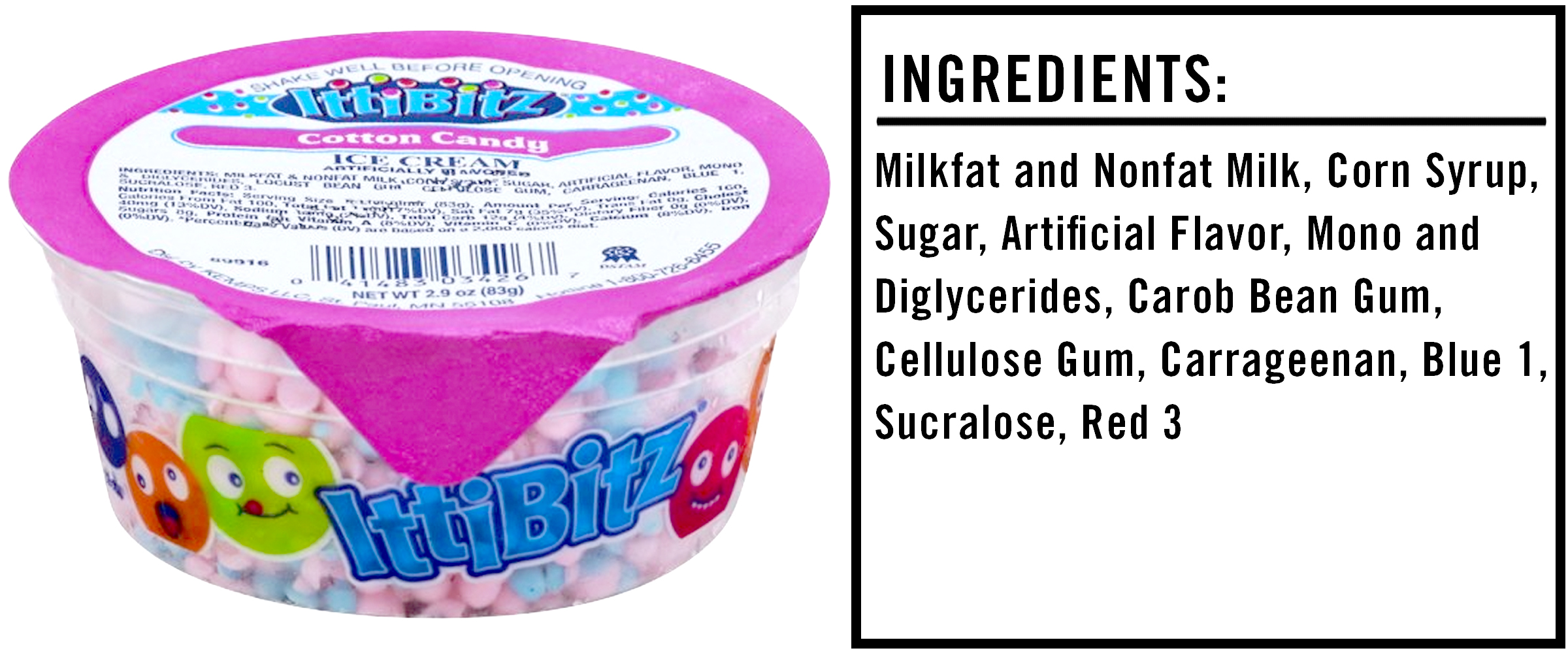We’re often told that you should never eat anything (or put anything on your body) if you don’t recognize everything on the ingredients list. But since most of us have no idea what xanthan gum or potassium benzoate are — or more importantly, what they’re doing to our bodies — we’re decoding the ingredients in the many things Americans put in (and on, or near) themselves.
This edition: Dippin’ Dots — erhm, well, IttiBitz, an alternative to Dippin’ Dots that you can actually get at grocery stores (the people over at Dippin’ Dots have explained that supermarket freezers are simply too damn warm to maintain the shape of their miniature cream balls, and I, as a result, am pissed). Rest assured, though, that the ingredients in both products are relatively similar, so without further ado, here are the ones lingering in the IttiBitz cotton candy ice cream, taken from the Walmart website and explained so you know what the hell is flooding your stomach.
The Ingredients
1) Milkfat and Nonfat Milk: Milkfat is the fatty portion of milk, and it’s usually added to processed foods as a means of adding heartiness and oftentimes a sort of creamy texture, which one would hope for from their ice cream. Nonfat milk, meanwhile, is milk without fat, duh.
2) Corn Syrup: Corn syrup is a liquid sweetener made of glucose. It doesn’t get as much negative publicity as high fructose corn syrup — which has been linked to obesity and diabetes by many, many studies (more on that here) — but regular corn syrup can also be debilitating, considering it’s basically liquid sugar.
3) Sugar: One cup of IttiBitz contains eight grams of sugar, which is a surprisingly reasonable amount — a single Snickers bar, for instance, delivers more than three times that. Nonetheless, sugar is still bad, and the American Heart Association recommends men consume no more than 36 grams and women consume no more than 25 grams of added sugar a day (and that doesn’t include sugar found naturally in foods like fruits and vegetables, either).
4) Artificial Flavor: Artificial flavors are chemical compounds created in a lab that mimic a natural flavor in some way (although, I have no idea how they manage to mimic cotton candy — I assume not well). While that may sound unhealthy, as physician and biochemist Cate Shanahan, author of Deep Nutrition: Why Your Genes Need Traditional Food, told me during my exploration of all 26 ingredients in nacho-flavored Doritos, these flavorings are added in such small quantities that they shouldn’t cause you any harm.
5) Mono and Diglycerides: This ingredient is typically added to food products as an emulsifier. In simpler terms, it helps all the ingredients properly blend together. But as I learned in my exploration of all 39 ingredients in the Dodger Dog, mono and diglycerides are oftentimes packed with trans fats that aren’t listed on the nutrition facts label, which is incredibly problematic. That’s because trans fats are associated with an increased risk of heart disease, stroke and diabetes, and consuming more than you think you are (because they weren’t listed on the label) could do serious damage to your body.
6) Carob Bean Gum: This is a natural food additive derived from — you guessed it — carob seeds. It’s used primarily as a thickening and stabilizing agent.
7) Cellulose Gum: Cellulose gum is another common thickening agent, and consuming large amounts of it may add bulk to your stool and have a laxative effect, according to the FDA. So, uh, if you experience a surge in toilet time after downing some dots, you now know why.
8) Carrageenan: This is widely used in the food industry for its gelling, thickening and stabilizing properties. Some animal studies argue that there’s a connection between carrageenan ingestion and inflammatory bowel disease; however, the FDA lists the ingredient as a Generally Recognized as Safe Substance. And more recent human studies take the FDA’s side on this one.
9) Blue 1: Artificial colors like this one are commonly considered to be carcinogenic. That said, again, Shanahan told me during my analysis of Doritos that studies arguing this are a bit flawed: “I’ve always been of the opinion that studies claiming artificial colors can cause cancer are irrelevant because [in the studies] they use really high amounts of the artificial colors — like, a million times more than you’d ever get [in your] food [throughout your lifetime].” All in all, the average person’s liver should be able to break down whatever minuscule amount of artificial coloring we consume with food.
10) Sucralose: This is an artificial sweetener (and one of the ingredients that the real Dippin’ Dots seems to avoid, which, good for them), more commonly known as Splenda. Unfortunately, studies suggest that sucralose increases the populations of bacteria in our gut that pull energy from our food and turn that energy into fat. Or in simpler terms, sucralose may make us overweight.
11) Red 3: See Blue 1 above.
The Takeaway
While not healthy by any means, IttiBitz does have a very reasonable amount of sugar, although like most ice creams, it’s still pretty high in fat, boasting 11 grams per cup. Nonetheless, if you can manage to limit yourself to one cup, because these dots are less dense than none-pelleted ice cream, you really won’t be consuming all that much of anything bad, making this a somewhat reasonable treat. Then again, if you go back for more and more, IttiBitz certainly has the capacity to fook your health. So as per usual, portion size is everything.


